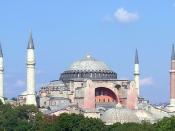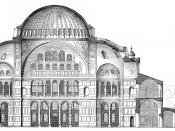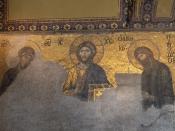As stated in our book, the artistic tradition of Byzantine culture was indeed, "monumental, kaleidoscopic, constantly open to fashion, energizing and far reaching". The works of art and especially the architecture of the Byzantine culture seem to perfectly embody these words in every aspect. One piece of Byzantine architecture that really does this well is the Hagia Sophia, located in Istanbul, Turkey. The Hagia Sophia is easily one of the greatest feats of architecture and construction in the world, and is sometimes even called the Eighth Wonder of the World. Every aspect of the Hagia Sophia is grand and extremely detailed and complex. During the Byzantine period, artists began to shift from the classical Greek style of using art to elevate man, and instead used their talents to elevate God. One way in which they did this was the use of Icons, or an image of Christ, The Virgin Mary, or a saint.
The Hagia Sophia was rebuilt to replace a church destroyed in riots that destroyed nearly half of Constantinople in 532. After the rioters had been crushed by Justinian, he chose two scholar-theoreticians to design the new church. These men were Anthemius of Tralles, and Isidorus of Miletos. Both of these men were well trained in mathematics and well very well qualified for the job. Despite the grand scale of this project and the relatively tedious building techniques, the Hagia Sophia was completed in an astonishing 5 years. Justinian was so proud of his new church, that he was said to have claimed, "Solomon, I have outdone you", meaning the Hagia Sophia is a greater work that the First Temple in Jerusalem. The main focal point of Hagia Sophia, is its enormous dome supported by a square base, and topped with a beautiful oculus. The design of the...


